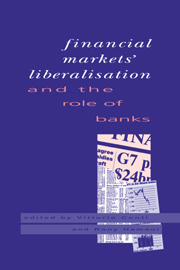Book contents
- Frontmatter
- Contents
- List of figures
- List of tables
- Preface
- Acknowledgements
- Notes on contributors
- Introduction
- PART I HOUSEHOLDS AND FIRMS
- 1 Marketable and non-marketable assets in households' portfolios: a cross-country comparison
- 2 Credit, money and consumption: time-series evidence for Italy
- Discussion
- 3 Empirical determinants of corporate debt decisions: some evidence for Italy
- Discussion
- PART II FINANCIAL MARKETS
- PART III BANKS
- Index
Discussion
Published online by Cambridge University Press: 20 March 2010
- Frontmatter
- Contents
- List of figures
- List of tables
- Preface
- Acknowledgements
- Notes on contributors
- Introduction
- PART I HOUSEHOLDS AND FIRMS
- 1 Marketable and non-marketable assets in households' portfolios: a cross-country comparison
- 2 Credit, money and consumption: time-series evidence for Italy
- Discussion
- 3 Empirical determinants of corporate debt decisions: some evidence for Italy
- Discussion
- PART II FINANCIAL MARKETS
- PART III BANKS
- Index
Summary
Introduction
Ordinary portfolio models are unable to explain the major differences evidenced by the data in the composition of households' financial assets in different countries. Giraldi, Hamaui and Rossi (hereafter GHR), following the suggestions of some earlier literature, argue that this is due to the neglect of the effects of non-marketable (i.e. illiquid or highly illiquid) assets on the structure of financial wealth. Considering Germany, Italy and the United Kingdom, they test (for the first time on aggregate data) an augmented portfolio model, where such non-marketable assets as pension funds, social-security wealth and the housing stock are made to play an explicit role in explaining assets' demand. They obtain remarkably successful results: the introduction of non-marketable wealth considerably improves the empirical performance of a portfolio model, and the difference in its size and composition in the three countries (which in turn depends on different institutional arrangements) appears to be a major factor of the different structure of marketable wealth. GHR then use their model to simulate the effects of tax harmonisation across the three countries on relative asset demand. Such effects turn out to be surprisingly modest, and this is taken by the authors as further corroboration of their finding: ‘in fact it is the structure of ‘adjusted’ returns – i.e. yields corrected for the covariances between marketable and non-marketable assets – which drives investors' choices’.
- Type
- Chapter
- Information
- Financial Markets Liberalisation and the Role of Banks , pp. 52 - 56Publisher: Cambridge University PressPrint publication year: 1993
- 1
- Cited by

